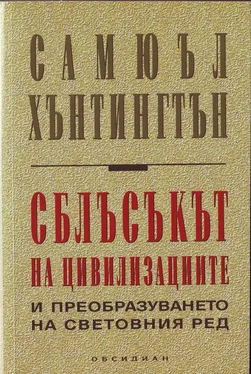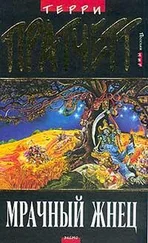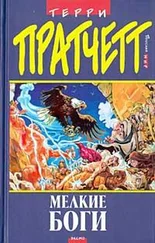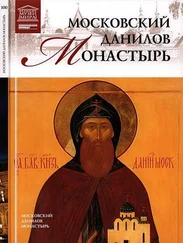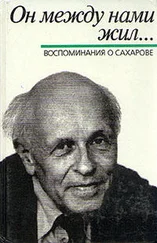Цитиран в Saturday Star (Johannesburg), 19 January 1991, p. 3; Economist, 26 January 1991, p. 31–33.
Султан на Египет (1138–1193). Завладява Сирия и участва в превземането на Ерусалим от християните през 1187 г. — Б. пр.
Sohail H. Hasmi, преглед на Mohammed Haikal, „Illusions of Triumph“, Harvard Middle Eastern and Islamic Review, 1 February 1994), 107; Mernissi, Islam and Democracy, p. 102.
Shibley Telhami, „Arab Public Opinion and the Gulf War“, Political Science Quarterly, 108 (Fall 1993), 451.
International Herald Tribune, 28 June 1993, p. 10.
Roy Licklider, „The Consequences of Negotiated Settlements in Civil Wars, 1945–93“, American Political Science Review, 89 (September 1995), 685, който дефинира гражданските войни като „войни за идентичност“, и Samuel P. Huntington, „Civil Violence and the Process of Development“, in Civil Violence and the International System (London: International Institute for Strategic Studies, Adelphi Paper No. 83, December 1971), 12–14, който изброява като пет главни характеристики на гражданските войни за идентичност: високата степен на поляризация, идеологическото двусмислие, сепаратизма, ожесточението и продължителността.
Тези оценки идват от материали в пресата и Ted Robert Gurr and Barbara Harff, Ethnic Conflict in World Politics (Boulder: Westview Press, 1994), pp. 160–165.
Richard H. Shultz, Jr. and William J. Olson, Ethnic and Religious Conflict: Emerging Threat to U.S. Security (Washington, D.C.: National Strategy Information Center), 17ff; H. D. S. Greenway, Boston Globe, 3 December 1992, p. 19.
Roy Licklider, „Settlements in Civil Wars“, p. 685; Gurr and Harff, Ethnic Conflict, p. 11; Trent N. Thomas, „Global Assessment of Current and Future Trends in Ethnic and Religious Conflict“, в Robert L. Pfaltzgraff, Jr. and Richard H. Shultz, Jr., eds., Ethnic Conflict and Regional Instability: Implications for U.S. Policy and Army Roles and Missions (Carlisle Barracks, PA: Strategic Studies Institute, U.S. Army War College, 1994), p. 36.
Вж. Shultz and Olson, Ethnic and Religious Conflict, pp. 3-9; Sugata Bose, „Factors Causing the Proliferation of Ethnic and Religious Conflict“, в Pfaltzgraff and Shultz, Ethnic Conflict and Regional Instability, pp. 43-49; Michael E. Brown, „Causes and Implications of Ethnic Conflict“ в Michael E. Brown, ed., Ethnic Conflict and International Security (Princeton, NJ: Princeton University Press, 1993), pp. 3–26. За контрааргумента, че етническите конфликти не са се увеличили от края на Студената война, вж. Thomas, „Global Assessment of Current and Future Trends in Ethnic and Religious Conflict“, pp. 33^41.
Въстание (ар.). — Б. пр.
Ruth Leger Sivard, World Military and Social Expenditures 1993 (Washington, DC: World Priorities, Inc., 1993), pp. 20–22.
Десет от тях са племенни конфликти в Африка.
Десет от които са племенни конфликти в Африка.
Никое друго твърдение от статията ми във „Форин Афеърс“ не предизвика толкова много критики, колкото следното: „Ислямът има кървави граници.“ Направих това заключение на базата на преглед на броя на жертвите в междуцивилизационните войни. Количествените данни от всички независими източници категорично потвърждават валидността му. — Б. а.
James L. Payne, Why Nations Arm (Oxford: B. Blackwell, 1989), p. 124.
Christopher B. Stone, Westphalia and Hudaybiyya: A Survey of Islamic Perspectives on the Use of Force as Conflict Management Technique (Harvard University, pp. 27–31, и Jonathan Wilkenfeld, Michael Brecher and Sheila Moser, eds., Crises in the Twentieth Century (Oxford: Pergamon Press, 1988–89), II, 15, 161.
Gary Fuller, „The Demographic Backdrop to Ethnic Conflict: A Geographic Overview“, в Central Intelligence Agency, The Challenge of Ethnic Conflict to National and International Order in the 1990s: Geographic Perspectives (Washington, D.C.: Central Intelligence Agency, RTT 95–10039, October 1995), pp. 151–154.
New York Times, 16 October 1994, p. 3; Economist, 5 August 1995, p. 32.
United Nations Department for Economic and Social Information and Policy Analysis, Population Division, World Population Prospects: The 1994 Revision (New York: United Nations, 1995), pp. 29, 51; Denis Dragounski, „Threshold of Violence“, Freedom Review, 26 (March/April 1995), 11.
Susan Woodward, Balkan Tragedy: Chaos and Dissolution after the Cold War (Washington, D.C.: Brookings Institution, 1995), pp. 32-35; Branka Magas, The Destruction of Yugoslavia: Tracking the Breakup 1980–92 (London: Verso, 1993), pp. 6, 19.
Paul Mojzes, Yugoslavian Inferno: Ethnoreligious Warfare in the Balkans (New York: Continuum, 1994), pp. 95-96; Magas, Destruction of Yugoslavia, pp. 49-73; Aryeh Neier, „Kosovo Survives“, New York Review of Books, 3 February 1994, p. 26.
Aleksa Djilas, „A Profile of Slobodan Milosevic“, Foreign Affairs, 72 (Summer 1993), 83.
Woodward, Balkan Tragedy, pp. 33–35. Данните са от югославски преброяванията населението и от други източници; William Т. Johnsen, Deciphering the Balkan Enigma: Using History to Inform Policy (Carlisle Barracks: Strategic Studies Institute, 1993), p. 25, цитиращ Washington Post, 6 December 1992, p. C2; New York Times, 4 November 1995, p. 6.
Bogdan Denis Denitch, Ethnic Nationalism: The Tragic Death of Yugoslavia (Minneapolis: University of Minnesota Press, 1994), pp. 108–109.
Payne, Why Nations Arm, pp. 125, 127.
Middle East International, 20 January 1995, p. 2.
Roy Licklider, „The Consequences of Negotiated Settlements in Civil Wars, 1945–93“, American Political Science Review, 89 (September 1995), 685.
Вж. Barry R. Posen, „The Security Dilemma and Ethnic Conflict“, в Michael E. Brown, ed., Ethnic Conflict and International Security (Princeton: Princeton University Press, 1993), pp. 103–124.
Roland Dannreuther, Creating New States in Central Asia (International Institute for Strategic Studies/Brassey’s, Adelphi Paper No. 288. March 1994), pp. 30-31; Dodjoni Atovullo, цитиран в Urzula Doroszewska, „The Forgotten War: What Really Happened in Tajikistan“, Uncaptive Minds, 6 (Fall 1993), 33.
Читать дальше
